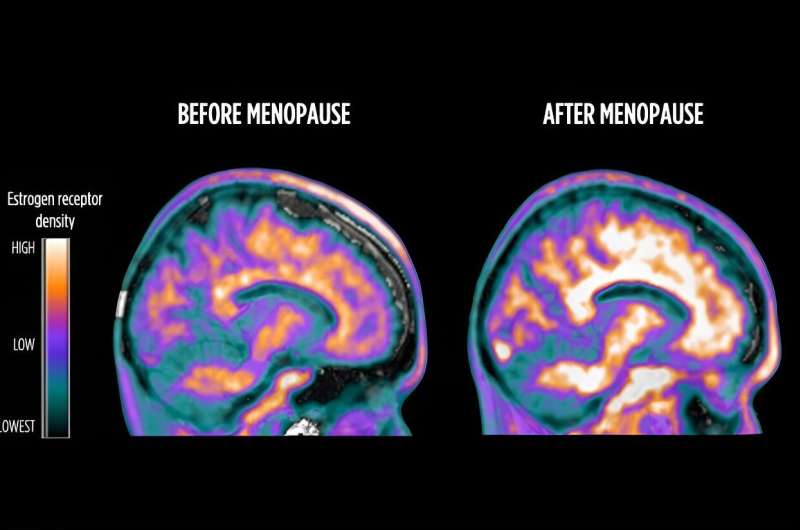This article has been reviewed according to Science X's editorial process and policies. Editors have highlighted the following attributes while ensuring the content's credibility:
fact-checked
peer-reviewed publication
trusted source
proofread
Scans show brain's estrogen activity changes during menopause

The transition to menopause is marked by a progressively higher density of estrogen receptors (ER) on brain cells, a measure that remains elevated in women up to their mid-sixties, according to a new brain imaging study led by researchers at Weill Cornell Medicine. In addition to revealing new evidence of the brain's response to this major life change, the study pioneers the use of positron emission tomography (PET) imaging as a tool for studying estrogen activity in the brain, which hasn't been possible to track until now.
In the study, which appears June 20 in Scientific Reports, the researchers scanned the brains of 54 healthy women aged 40–65 using PET with a tracer that binds to ERs.
These receptors are found in multiple areas of the brain, especially in women, and mediate the many cognitive and behavioral effects of the female sex hormone estradiol, the most potent form of estrogen. ER-PET scans have been employed in prior studies of women with cancer, but never before in a study of healthy women's brains.
Scans comparing women at different menopausal stages revealed progressively higher ER density in several estrogen-regulated brain networks in the postmenopausal and perimenopausal groups compared to premenopausal controls. The researchers interpret this as a compensatory response to waning levels of available estrogen— as estrogen levels drop during the menopause transition, the cells express additional receptors to sop up as much estrogen as possible.
The researchers' analyses found that high ER density in some of these regions was associated not only with menopause status but also with patients' reports of menopause-related cognitive and mood symptoms.
The results suggest that the technique may be a valuable tool for studying the brain effects of menopause and estrogen therapy.
"Using this method, we were able for the first time to measure ER activity in the brain, and to identify potential predictors of some of these common symptoms of menopause," said study lead author Dr. Lisa Mosconi, associate professor of neuroscience in neurology and radiology, and director of the Women's Brain Initiative at Weill Cornell Medicine.
A central feature of menopause is the decline in the body's production of estrogens. This leads to various bodily changes including the cessation of menstruation, but also to neuropsychiatric effects such as "brain fog," depression and anxiety.
To understand the detailed molecular mechanisms underlying these estrogen-related brain symptoms, researchers would need a reliable, minimally invasive method for measuring estrogen activity in the brain.
The new study was a proof-of-principle demonstration that PET imaging with a specific ER-binding tracer, called 18F-fluoroestradiol (FES), could meet that need.
The researchers imaged 18 premenopausal, 18 perimenopausal, and 18 post-menopausal women aged 40–65, and recorded the density of ERs in various brain regions known to be regulated by estrogen.
The results showed significantly higher ER density in the brains of postmenopausal women compared with premenopausal women, with intermediate levels in perimenopausal women. A measure based on ER density in four key brain regions, the pituitary gland, caudate nucleus, posterior cingulate cortex, and middle frontal cortex, predicted postmenopausal versus premenopausal status with 100% accuracy.
In postmenopausal women, higher densities in cognitive regions such as the hippocampus and frontal cortex were associated with lower scores on some cognitive tests. In the same group, higher densities in a different set of brain regions including the thalamus were associated with mood symptoms such as depression.
The investigators plan to use ER-PET imaging to study the long-term consequences of estrogen levels changes in the brain—including persistently low levels after menopause, and rising levels with estrogen therapy.
"We hope to learn, for example, whether ER density changes with estrogen therapy, and if that leads to fewer symptoms and better performance on cognitive tests," said Dr. Mosconi, who is also the director of the Alzheimer's Prevention Program at Weill Cornell Medicine and NewYork-Presbyterian.
The finding that ERs, instead of disappearing swiftly after menopause, remain abundant in the brain up to a decade after menopause, along with findings that elevated ER density was observed during perimenopause, also hints that the "window of opportunity" for estrogen therapy may be greater than thought, she said.
More information: Lisa Mosconi et al, In vivo brain estrogen receptor density by neuroendocrine aging and relationships with cognition and symptomatology, Scientific Reports (2024). DOI: 10.1038/s41598-024-62820-7



















